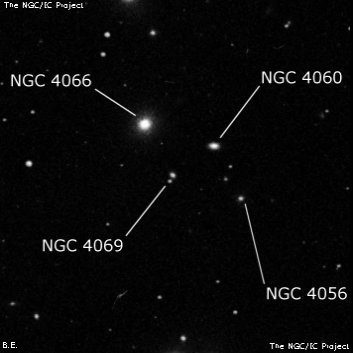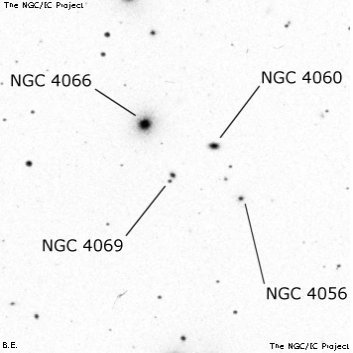NGC/IC Project Restoration Effort
(This is a very very beta version)
NGC4069


Basic Information
Location and Magnitude
Right Ascension: 12:4:6.1
Declination: +20:19:28
Constellation: COM
Visual Magnitude: 15.2
Historic Information
Discoverer: Herschel W.
Year of discovery: 1785
Discovery aperture: 18.7
Observational
Summary description: vF, vS
Sub-type: S
Corwin's Notes
=====
NGC 4069. This is one of the galaxies found by John Herschel during the
problematic Sweep 423 of 29 April 1832 (see NGC 4055 for a list of the nebulae
found during the sweep). Unfortunately, Herschel saw it only during that one
sweep, so its position is not well-determined. Also, it is in the midst of a
group of nebulae found by William Herschel, and later reobserved by Heinrich
d'Arrest. Making reasonable assumptions about the six objects found by Sir
William (he measured positions only for the northern three of those he saw,
saying only that the other three were 10-12 arcmin south) leads to the
conclusion that d'Arrest got the same six. NGC 4069 (= h1070) is not among
them, in spite of the identity with H III 392 given in NGC. The three
measured by Herschel are N4066, N4070, and N4074; and his other three to the
south must be N4061, N4065, and N4076. These are the six brightest objects in
the group.
There are four other NGC objects scattered through the group. Unfortunately,
only one can be pinned down with any certainty. That one is NGC 4072,
discovered by Ralph Copeland with Lord Rosse's Leviathan. His description
(dated 3 April 1872) also makes it clear that he saw the fainter galaxy two
minutes north-following N4076. The confusion in the positions, though, led
Dreyer to not assign an NGC number to this galaxy.
In any case, N4069 is one of the remaining three (the other two are N4056 and
N4060, found by Marth; see the discussion of these). RNGC makes N4069 the
faint galaxy just north-preceding a star (both are in GSC), but the nearby
RNGC 4060 is considerably brighter. Herschel's description, however, "vF, R,
4th of 5; has another on same meridian, north" doesn't support the identity
with RNGC 4060. There is the possibility, however, that the star just
south-following RNGC 4069 was "blended" with the galaxy so that the two
objects together would appear as a single brighter nebula. This would save
the description of "another on the same meridian, north," and would be
relatively close to Sir John's position. Lacking any better hypothesis at the
moment, we'll adopt the RNGC identification.
Steve's Notes
=====
NGC 4069
24" (3/22/14): faint, very small, round, 15" diameter. Located 1.7' SSE of NGC 4066. NGC 4060 lies 1.5' NW and an extremely faint galaxy (possibly NGC 4056) lies 2.0' SW. Either I missed the mag 16 star just off the southeast edge (~10" from center) or the galaxy and star were merged together
17.5" (5/14/88): extremely faint and small, round. Located 1.7' SSW of NGC 4066. Forms an equilateral triangle with NGC 4060 and NGC 4066 within the NGC 4065 cluster. The NGC identification of this number is not certain.



